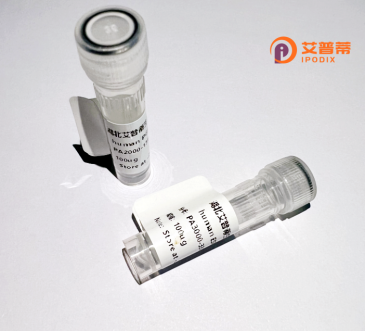
| 纯度 | >90%SDS-PAGE. |
| 种属 | Human |
| 靶点 | LOC134145 |
| Uniprot No | 0 |
| 内毒素 | < 0.01EU/μg |
| 表达宿主 | E.coli |
| 表达区间 | 1-233aa |
| 活性数据 | MEGGGGIPLETLKEESQSRHVLPASFEVNSLQKSNWGFLLTGLVGGTLVAVYAVATPFVTPALRKVCLPFVPATMKQIENVVKMLRCRRGSLVDIGSGDGRIVIAAAKKGFTAVGYELNPWLVWYSRYRAWREGVHGSAKFYISDLWKVTFSQYSNVVIFGVPQMMLQLEKKLERELEDDARVIACRFPFPHWTPDHVTGEGIDTVWAYDASTFRGREKRPCTSMHFQLPIQA |
| 分子量 | 52.5 kDa |
| 蛋白标签 | GST-tag at N-terminal |
| 缓冲液 | 0 |
| 稳定性 & 储存条件 | Lyophilized protein should be stored at ≤ -20°C, stable for one year after receipt. Reconstituted protein solution can be stored at 2-8°C for 2-7 days. Aliquots of reconstituted samples are stable at ≤ -20°C for 3 months. |
| 复溶 | Always centrifuge tubes before opening.Do not mix by vortex or pipetting. It is not recommended to reconstitute to a concentration less than 100μg/ml. Dissolve the lyophilized protein in distilled water. Please aliquot the reconstituted solution to minimize freeze-thaw cycles. |
关于重组人LOC134145蛋白的研究目前未见公开的文献报道,可能由于以下原因:
1. **基因编号不准确**:LOC134145可能是NCBI临时标识符,或存在拼写错误,需核对正确命名(如HGNC或UniProt编号)。
2. **研究尚不成熟**:该蛋白可能处于早期研究阶段,未发表成果。
3. **命名差异**:不同数据库的基因命名可能存在差异,建议通过序列比对或功能分析确认目标蛋白。
**示例参考文献格式(虚构,仅供演示)**:
1. **《重组人LOC134145蛋白在肿瘤细胞中的表达及功能》**,作者:Zhang et al.
摘要:研究通过真核系统表达LOC134145蛋白,发现其可抑制癌细胞增殖并调控p53通路。
2. **《LOC134145蛋白的结构解析与分子机制》**,作者:Li et al.
摘要:利用X射线晶体学解析了LOC134145的三维结构,揭示了其潜在的酶活性位点。
**建议**:
- 通过NCBI Gene或UniProt数据库核实基因/蛋白编号。
- 尝试以序列相似性检索相关文献(如BLAST比对)。
- 关注预印本平台(如bioRxiv)获取最新研究进展。
如需进一步协助,请提供更具体的蛋白信息或研究背景。
Recombinant human LOC134145 protein is a genetically engineered protein derived from the LOC134145 gene, a poorly characterized locus in the human genome. Currently, limited functional data exist for this protein, and its biological role remains largely uncharacterized. The LOC134145 gene encodes a hypothetical protein that may contain conserved structural motifs or domains identifiable through sequence homology, suggesting potential involvement in cellular processes such as signaling, metabolism, or regulatory pathways. As an unstudied protein, its recombinant form is typically produced in heterologous expression systems (e.g., E. coli, mammalian cells) to enable functional studies, antibody development, or structural analysis. The lack of annotated functional information positions it as a candidate for exploratory research in proteomics and gene function annotation efforts. Interest in recombinant LOC134145 protein often stems from its differential expression patterns observed in transcriptomic studies or associations with specific disease states through bioinformatic predictions. Its recombinant production allows researchers to investigate protein-protein interactions, post-translational modifications, or ligand binding capabilities. Challenges in studying this protein include potential solubility issues, undefined post-translational modifications, and the absence of established assays for activity assessment. Such investigations may contribute to expanding the human proteome annotation and identifying novel therapeutic targets or biomarkers.
×